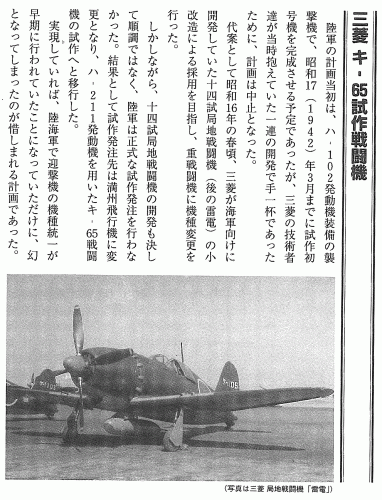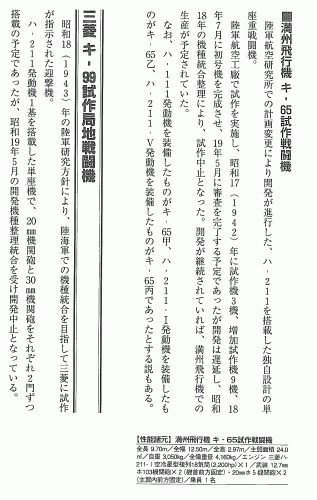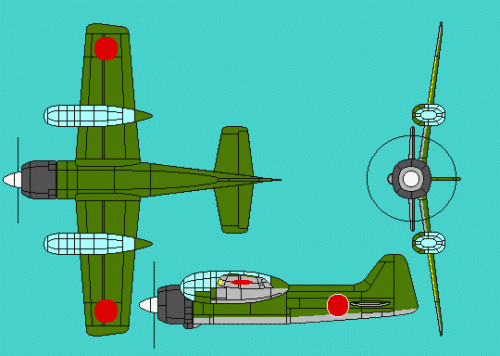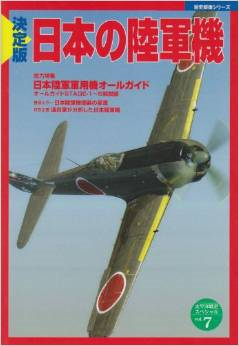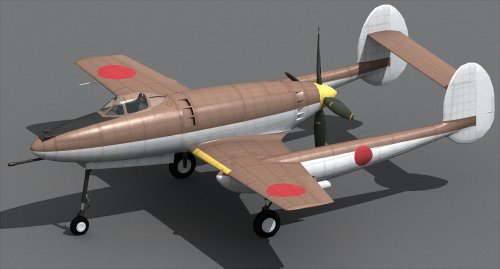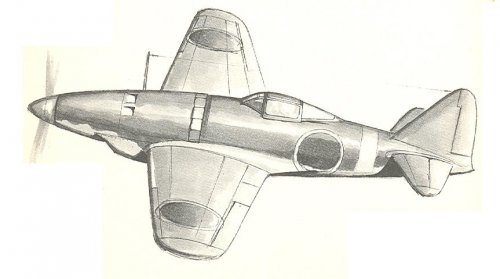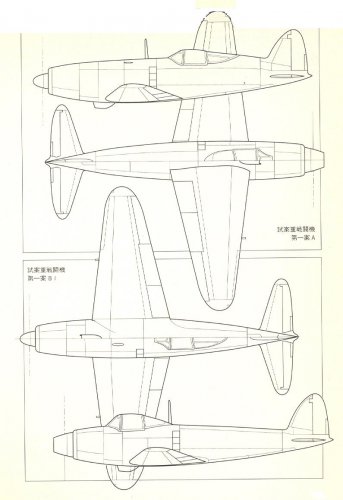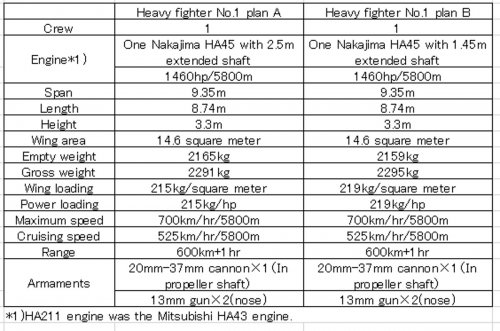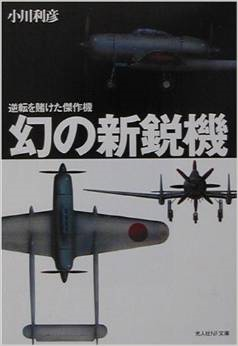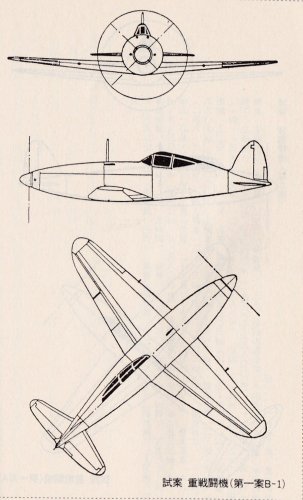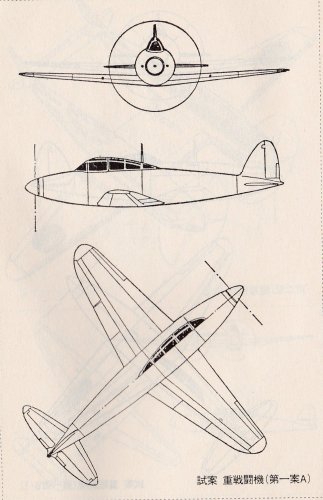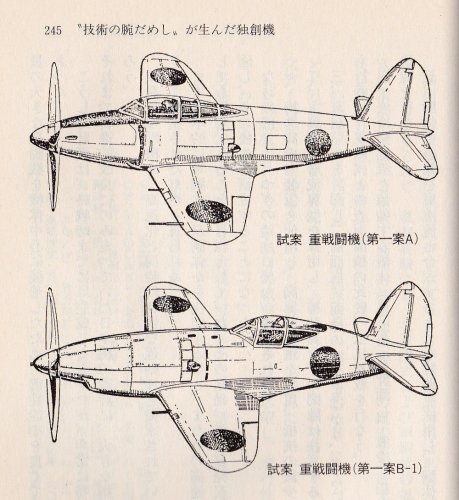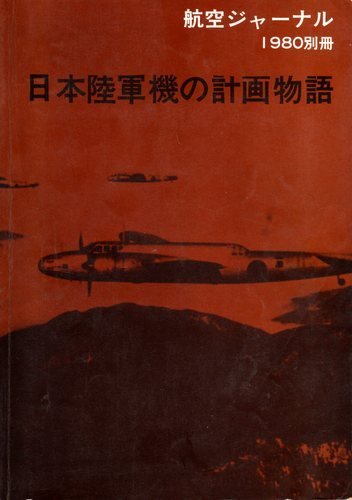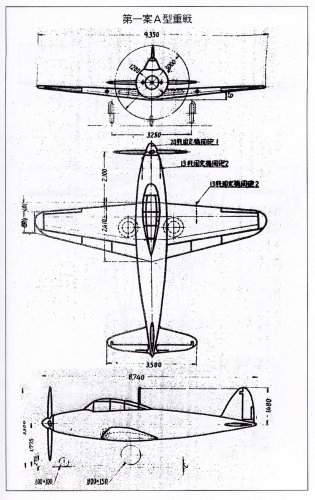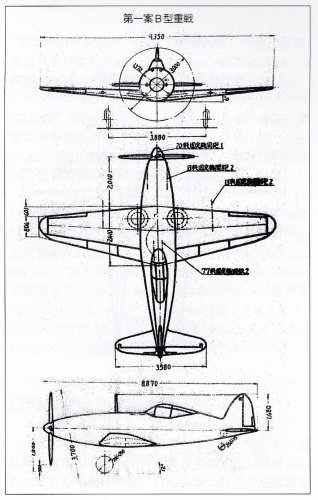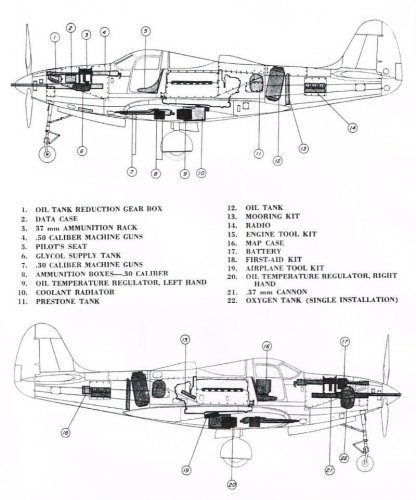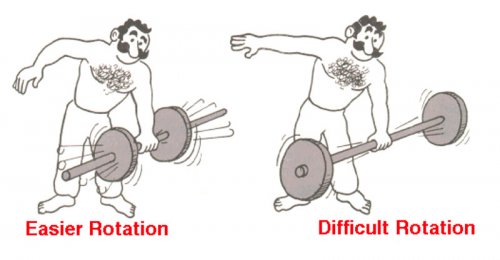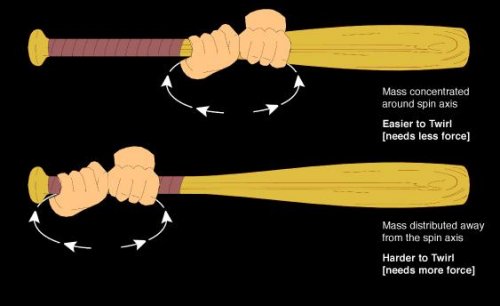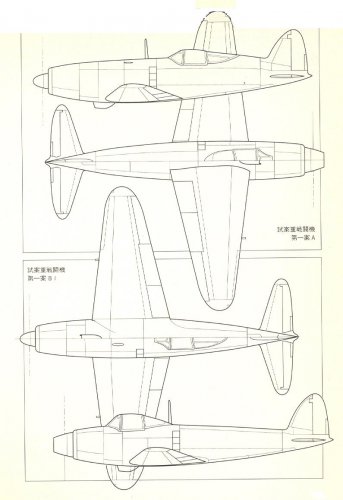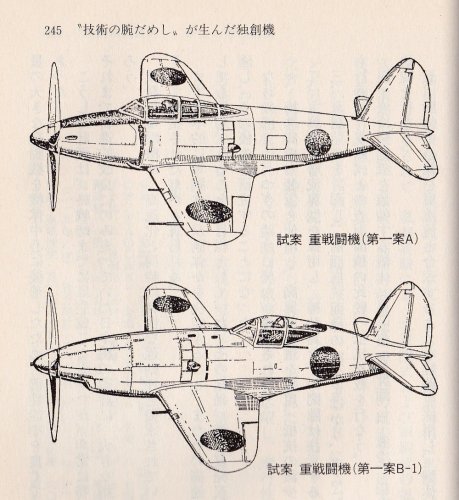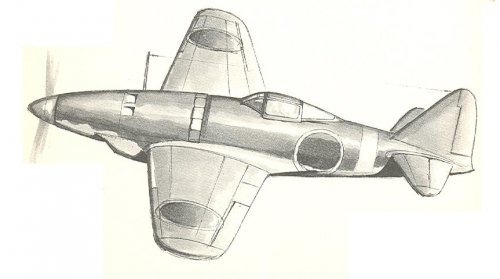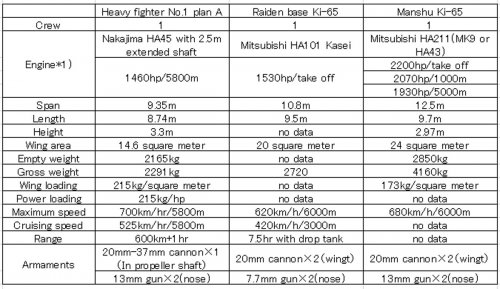You are using an out of date browser. It may not display this or other websites correctly.
You should upgrade or use an alternative browser.
You should upgrade or use an alternative browser.
Manshu Ki-65 heavy fighter
- Thread starter gerhard
- Start date
- Joined
- 25 July 2007
- Messages
- 4,299
- Reaction score
- 4,198
Re: Mansyu Ki-65 question
Yes, do tell. A Mitsubishi connection would be most interesting! Because Manshyu built Nakajima fighters, I'd always wondered if the Ki-65 might have been a Ki-62 derivative.
Yes, do tell. A Mitsubishi connection would be most interesting! Because Manshyu built Nakajima fighters, I'd always wondered if the Ki-65 might have been a Ki-62 derivative.
Tophe
ACCESS: Top Secret
Re: Mansyu Ki-65 question
In the Docavia (French) book 'les chasseurs japonais", page 231 (my translation here, imperfect sorry):
"the Nakajima company designed a plane with an in-line engine, competitor of the Ki.61 Hien (...). From the same program of 1940, the company Mansyu, from Harbin (Mandchoury) competed with the interesting project Ki.65. Single-seater single-engine to replace the Ki.44 Shoki as interceptor, speedy and well armed. At first, it used a 18-cylinder double-star engine Mitsubishi Ha.211 of 2,200hp and an armament of two 20mm guns and two 12.7mm machine guns. The Koku Hombu made suggestions, and were created variants like the Ki.65a with a 1,850hp 14-cylinder engine Mitsubishi Ha.111, and the Ki.65b with a Ha.211-I, and the Ki.65c with a Ha.211-V. None of these models left the drawing board."
(no picture of them in this book)
In the Docavia (French) book 'les chasseurs japonais", page 231 (my translation here, imperfect sorry):
"the Nakajima company designed a plane with an in-line engine, competitor of the Ki.61 Hien (...). From the same program of 1940, the company Mansyu, from Harbin (Mandchoury) competed with the interesting project Ki.65. Single-seater single-engine to replace the Ki.44 Shoki as interceptor, speedy and well armed. At first, it used a 18-cylinder double-star engine Mitsubishi Ha.211 of 2,200hp and an armament of two 20mm guns and two 12.7mm machine guns. The Koku Hombu made suggestions, and were created variants like the Ki.65a with a 1,850hp 14-cylinder engine Mitsubishi Ha.111, and the Ki.65b with a Ha.211-I, and the Ki.65c with a Ha.211-V. None of these models left the drawing board."
(no picture of them in this book)
Re: Mansyu Ki-65 question
Thanx
I cannot read Japanese but I gathered more or less the same from this paragraph. Thanks for your translation Tophe. My source is IJA Experimental Aircraft 1943-1945 by Ikaros and available through HLJ. Can someone perhaps assist with this text?
Cheers
Gerhard
Thanx
I cannot read Japanese but I gathered more or less the same from this paragraph. Thanks for your translation Tophe. My source is IJA Experimental Aircraft 1943-1945 by Ikaros and available through HLJ. Can someone perhaps assist with this text?
Cheers
Gerhard
Attachments
blackkite
Don't laugh, don't cry, don't even curse, but.....
- Joined
- 31 May 2007
- Messages
- 8,820
- Reaction score
- 7,721
Re: Mansyu Ki-65 question
Mitsubishi Ki-65 experimental fighter
At first, IJA planned Ki-65 as Ha-102 powered attack aircraft, and hoped first prototype completed in March 1942.
But Mitsubishi's engineers were too busy by other projects, Mitsubishi planned alternative Ki-65 concept which was Raiden small modified heavy fighter.
But Raiden's development work was not so smooth, IJA did not gave Mitsubishi an order for prototype production.
Finally IJA gave Manshu an order for Ha-211 powered Ki-65.
If Mitsubishi KI-65 heavy fighter was realized, it was the first case of IJA and IJN interceptor unification.
Mitsubishi Ki-65 experimental fighter
At first, IJA planned Ki-65 as Ha-102 powered attack aircraft, and hoped first prototype completed in March 1942.
But Mitsubishi's engineers were too busy by other projects, Mitsubishi planned alternative Ki-65 concept which was Raiden small modified heavy fighter.
But Raiden's development work was not so smooth, IJA did not gave Mitsubishi an order for prototype production.
Finally IJA gave Manshu an order for Ha-211 powered Ki-65.
If Mitsubishi KI-65 heavy fighter was realized, it was the first case of IJA and IJN interceptor unification.
blackkite
Don't laugh, don't cry, don't even curse, but.....
- Joined
- 31 May 2007
- Messages
- 8,820
- Reaction score
- 7,721
Re: Mansyu Ki-65 question
http://www.warbirds.jp/kakuki/sakka/saksuda.htm
Of course it's fake. Enjoy.
http://www.warbirds.jp/kakuki/sakka/saksuda.htm
Of course it's fake. Enjoy.
Tophe
ACCESS: Top Secret
Re: Mansyu Ki-65 question
Thanks a lot for this link, wonderful. ;D while... I have not seen "65" there, which would it be? I hope the uncommon design below:blackkite said:http://www.warbirds.jp/kakuki/sakka/saksuda.htm
Of course it's fake. Enjoy.
Attachments
blackkite
Don't laugh, don't cry, don't even curse, but.....
- Joined
- 31 May 2007
- Messages
- 8,820
- Reaction score
- 7,721
Re: Mansyu Ki-65 question
The second plane's explanation is as follows.
Ki-65 Mitsubishi experimental twin engine single seat high speed light bomber.
(キ:Ki ,三菱:Mitsubishi ,試作:experimental ,双発:twin engine,単座:single seat,高速:high speed,
軽:light,爆撃機:bomber)
The second plane's explanation is as follows.
Ki-65 Mitsubishi experimental twin engine single seat high speed light bomber.
(キ:Ki ,三菱:Mitsubishi ,試作:experimental ,双発:twin engine,単座:single seat,高速:high speed,
軽:light,爆撃機:bomber)
Re: Mansyu Ki-65 question
I don’t think that the picture from the “Warbird” site is reliable or even viable. The IJA was way too conservative for such a strange design. I doubt that this plane is streamline or manoeuvrable enough for a heavy fighter.
Thanks for the breakdown, Blackkite. It makes more sense that way.
Cheers
Gerhard
I don’t think that the picture from the “Warbird” site is reliable or even viable. The IJA was way too conservative for such a strange design. I doubt that this plane is streamline or manoeuvrable enough for a heavy fighter.
Thanks for the breakdown, Blackkite. It makes more sense that way.
Cheers
Gerhard
blackkite
Don't laugh, don't cry, don't even curse, but.....
- Joined
- 31 May 2007
- Messages
- 8,820
- Reaction score
- 7,721
Development of Kawasaki Ki-60 heavy fighter, Nakajima Ki-63 heavy fighter and Kawasaki Ki-64 heavy fighter planned by the line of investigation in 1940 did not go smoothly.
In spring of 1941, the aviation technology research institute of Imperial Japanese Army fixed its eyes on the high performance of the 14-shi interceptor (Raiden) which the Imperial Japanese navy was making as an experiment.
And the aviation technology research institute of Imperial Japanese Army started examination which adopts this fighter as the fighter even in Imperial Japanese Army on the assumption that the minimum modification was given.
The IJA decided to confer the name of Ki-65 upon this fighter.
Development of attack airplane Ki-65 which equipped Ha 102 engine, planned to order to Mitsubishi was stopped.
However, development of Raiden interceptor was not favorable, either.
The Imperial Japanese army aviation technology research institute started uniquely examination of the heavy fighter equipped with Ha 211 more powerful engine.
Manshu Aircraft was selected as the Production manufacturer of this heavy fighter.
Ki-65 heavy fighter changed the shape again.
This Ki-65 heavy fighter aimd at the maximal speed of 680 km/h, and manufacture of three trial production airplanes and nine additional trial production airplanes was planned in 1942.
Mass-produced type completion of No. 1 is scheduled for July, 1943, and an army examination was due to be completed in May, 1944.
Research of Ki-65 heavy fighter was replaced with Ki-98 more novel fighter although continued till the middle of 1942.
Source: The IJA aircrafts, Gakken, ISBN978-4-05-606220-5 (Super book!!)
http://www.amazon.co.jp/s/ref=nb_sb_noss?__mk_ja_JP=%E3%82%AB%E3%82%BF%E3%82%AB%E3%83%8A&url=search-alias%3Daps&field-keywords=+ISBN978-4-05-606220-5+
Hi ED! Can you find a 3-side view drawing of this design?
In spring of 1941, the aviation technology research institute of Imperial Japanese Army fixed its eyes on the high performance of the 14-shi interceptor (Raiden) which the Imperial Japanese navy was making as an experiment.
And the aviation technology research institute of Imperial Japanese Army started examination which adopts this fighter as the fighter even in Imperial Japanese Army on the assumption that the minimum modification was given.
The IJA decided to confer the name of Ki-65 upon this fighter.
Development of attack airplane Ki-65 which equipped Ha 102 engine, planned to order to Mitsubishi was stopped.
However, development of Raiden interceptor was not favorable, either.
The Imperial Japanese army aviation technology research institute started uniquely examination of the heavy fighter equipped with Ha 211 more powerful engine.
Manshu Aircraft was selected as the Production manufacturer of this heavy fighter.
Ki-65 heavy fighter changed the shape again.
This Ki-65 heavy fighter aimd at the maximal speed of 680 km/h, and manufacture of three trial production airplanes and nine additional trial production airplanes was planned in 1942.
Mass-produced type completion of No. 1 is scheduled for July, 1943, and an army examination was due to be completed in May, 1944.
Research of Ki-65 heavy fighter was replaced with Ki-98 more novel fighter although continued till the middle of 1942.
Source: The IJA aircrafts, Gakken, ISBN978-4-05-606220-5 (Super book!!)
http://www.amazon.co.jp/s/ref=nb_sb_noss?__mk_ja_JP=%E3%82%AB%E3%82%BF%E3%82%AB%E3%83%8A&url=search-alias%3Daps&field-keywords=+ISBN978-4-05-606220-5+
Hi ED! Can you find a 3-side view drawing of this design?
Attachments
windswords
ACCESS: Secret
- Joined
- 19 May 2009
- Messages
- 389
- Reaction score
- 218
I found this web site in Italian that mentions the Ki-65. You can run it through Google Translate. They don't know what it looks like either.
http://www.aereimilitari.org/forum/topic/12590-manshu-ki-65/
http://www.aereimilitari.org/forum/topic/12590-manshu-ki-65/
blackkite
Don't laugh, don't cry, don't even curse, but.....
- Joined
- 31 May 2007
- Messages
- 8,820
- Reaction score
- 7,721
windswords said:I found this web site in Italian that mentions the Ki-65. You can run it through Google Translate. They don't know what it looks like either.
http://www.aereimilitari.org/forum/topic/12590-manshu-ki-65/
Oh! Fake or not, this is a light bomber.
blackkite
Don't laugh, don't cry, don't even curse, but.....
- Joined
- 31 May 2007
- Messages
- 8,820
- Reaction score
- 7,721
This one?
The influence of Raiden is also felt and these proposed plans also resemble the engine cooling method of Ki-98.
試案重戦闘機 : Trial plan for heavy fighter
The influence of Raiden is also felt and these proposed plans also resemble the engine cooling method of Ki-98.
試案重戦闘機 : Trial plan for heavy fighter
Attachments
blackkite
Don't laugh, don't cry, don't even curse, but.....
- Joined
- 31 May 2007
- Messages
- 8,820
- Reaction score
- 7,721
Hi next drawing.
Source : The new aircrafts of a phantom(幻の新鋭機), Kojinsha, ISBN4-7698-2142-5
http://www.amazon.co.jp/%E5%B9%BB%E3%81%AE%E6%96%B0%E9%8B%AD%E6%A9%9F%E2%80%95%E9%80%86%E8%BB%A2%E3%82%92%E8%B3%AD%E3%81%91%E3%81%9F%E5%82%91%E4%BD%9C%E6%A9%9F-%E5%85%89%E4%BA%BA%E7%A4%BENF%E6%96%87%E5%BA%AB-%E5%B0%8F%E5%B7%9D-%E5%88%A9%E5%BD%A6/dp/4769821425/ref=sr_1_1?ie=UTF8&qid=1410585973&sr=8-1&keywords=4769821425
Source : The new aircrafts of a phantom(幻の新鋭機), Kojinsha, ISBN4-7698-2142-5
http://www.amazon.co.jp/%E5%B9%BB%E3%81%AE%E6%96%B0%E9%8B%AD%E6%A9%9F%E2%80%95%E9%80%86%E8%BB%A2%E3%82%92%E8%B3%AD%E3%81%91%E3%81%9F%E5%82%91%E4%BD%9C%E6%A9%9F-%E5%85%89%E4%BA%BA%E7%A4%BENF%E6%96%87%E5%BA%AB-%E5%B0%8F%E5%B7%9D-%E5%88%A9%E5%BD%A6/dp/4769821425/ref=sr_1_1?ie=UTF8&qid=1410585973&sr=8-1&keywords=4769821425
Attachments
blackkite
Don't laugh, don't cry, don't even curse, but.....
- Joined
- 31 May 2007
- Messages
- 8,820
- Reaction score
- 7,721
Maveric said:Great post blackkite, THANKS. All of these projects designed by Mitsubishi?
No Maveric. These basic plans were designed by the aviation technology research institute of the Imperial Japanese Army. And planned to manufacture by the Manshu aircraft Co. Perhaps detail design of Ki-65 was planned to order to Manshu Aircraft Co.
perttime
I really did change my personal text
- Joined
- 30 March 2013
- Messages
- 311
- Reaction score
- 318
The specifications image gives measurements for a small fighter. That makes me think more of a short range interceptor than a heavy fighter - which is just fine by me.blackkite said:Hi next drawing.
Source : The new aircrafts of a phantom(幻の新鋭機), Kojinsha, ISBN4-7698-2142-5
blackkite
Don't laugh, don't cry, don't even curse, but.....
- Joined
- 31 May 2007
- Messages
- 8,820
- Reaction score
- 7,721
Hi! The IJA called heavy fighter and light bfighter as follows,
Heavy fighter(重戦闘機) :
Relatively high speed. Select hit and escape strategy. High speed and high climb rate are the main performance. Enemy bomber interceptor is the primary mission. (Ki-44, Ki-60, Ki-63, Ki-64, Ki-87, Ki-94...)
Light fighter(軽戦闘機) :
Air superiority fighter.(Ki-27, Ki-43, Ki-62...)
Medium fighter(中戦闘機) : Ki-61, Ki-84?...
(Japanese wikipedia, etc)
Heavy fighter(重戦闘機) :
Relatively high speed. Select hit and escape strategy. High speed and high climb rate are the main performance. Enemy bomber interceptor is the primary mission. (Ki-44, Ki-60, Ki-63, Ki-64, Ki-87, Ki-94...)
Light fighter(軽戦闘機) :
Air superiority fighter.(Ki-27, Ki-43, Ki-62...)
Medium fighter(中戦闘機) : Ki-61, Ki-84?...
(Japanese wikipedia, etc)
blackkite
Don't laugh, don't cry, don't even curse, but.....
- Joined
- 31 May 2007
- Messages
- 8,820
- Reaction score
- 7,721
Not at all great hesham!
If it says honestly, I have no confidence whether these drawings are drawings of Ki-65 heavy fighter.
According to the book of Gakken, the engine of Ki-65 is Ha 211 (Mitsubishi Ha 43(MK9)), but it is indicated for description of these drawings that an engine is Nakajima Ha 45(NK9).
Moreover, according to the book of Gakken, although the maximal speed of Ki-65 is 680 km/h, the maximal speed of these drawings is 700 km/h.
There is a delicate difference.
However, I think that the shape of Ki-65 resembles these drawings, because all of these plans were designed by the aviation technology research institute of Imperial Japanese Army
If it says honestly, I have no confidence whether these drawings are drawings of Ki-65 heavy fighter.
According to the book of Gakken, the engine of Ki-65 is Ha 211 (Mitsubishi Ha 43(MK9)), but it is indicated for description of these drawings that an engine is Nakajima Ha 45(NK9).
Moreover, according to the book of Gakken, although the maximal speed of Ki-65 is 680 km/h, the maximal speed of these drawings is 700 km/h.
There is a delicate difference.
However, I think that the shape of Ki-65 resembles these drawings, because all of these plans were designed by the aviation technology research institute of Imperial Japanese Army
blackkite
Don't laugh, don't cry, don't even curse, but.....
- Joined
- 31 May 2007
- Messages
- 8,820
- Reaction score
- 7,721
Mitsubishi tried to develop Senden based on Raiden and Manshu tried to develop Ki-98 based on Ki-65.
So Raiden was a mother of Senden, Ki-65 and Ki-98. Clean shape, force cooling fan and extended propeller shaft.
So Raiden was a mother of Senden, Ki-65 and Ki-98. Clean shape, force cooling fan and extended propeller shaft.
Hi Blackkite san again amazing pictures well done!blackkite said:This one?
The influence of Raiden is also felt and these proposed plans also resemble the engine cooling method of Ki-98.
試案重戦闘機 : Trial plan for heavy fighter
are these pre design studies of the manshu fighter or are these separate designs to develop a successor to for example the Mitsubishi F1M raiden?
blackkite
Don't laugh, don't cry, don't even curse, but.....
- Joined
- 31 May 2007
- Messages
- 8,820
- Reaction score
- 7,721
Thanks T-50 san! Please confirm my following first post of this topic or you can find the answer of your question.T-50 said:Hi Blackkite san again amazing pictures well done!blackkite said:This one?
The influence of Raiden is also felt and these proposed plans also resemble the engine cooling method of Ki-98.
試案重戦闘機 : Trial plan for heavy fighter
are these pre design studies of the manshu fighter or are these separate designs to develop a successor to for example the Mitsubishi F1M raiden?
Development of Kawasaki Ki-60 heavy fighter, Nakajima Ki-63 heavy fighter and Kawasaki Ki-64 heavy fighter planned by the line of investigation in 1940 did not go smoothly.
In spring of 1941, the aviation technology research institute of Imperial Japanese Army fixed its eyes on the high performance of the 14-shi interceptor (Raiden) which the Imperial Japanese navy was making as an experiment.
And the aviation technology research institute of Imperial Japanese Army started examination which adopts this fighter as the fighter even in Imperial Japanese Army on the assumption that the minimum modification was given.
The IJA decided to confer the name of Ki-65 upon this fighter.
Development of attack airplane Ki-65 which equipped Ha 102 engine, planned to order to Mitsubishi was stopped.
However, development of Raiden interceptor was not favorable, either.
The Imperial Japanese army aviation technology research institute started uniquely examination of the heavy fighter equipped with Ha 211 more powerful engine.
Manshu Aircraft was selected as the Production manufacturer of this heavy fighter.
Ki-65 heavy fighter changed the shape again.
This Ki-65 heavy fighter aimd at the maximal speed of 680 km/h, and manufacture of three trial production airplanes and nine additional trial production airplanes was planned in 1942.
Mass-produced type completion of No. 1 is scheduled for July, 1943, and an army examination was due to be completed in May, 1944.
Research of Ki-65 heavy fighter was replaced with Ki-98 more novel fighter although continued till the middle of 1942.
Source: The IJA aircrafts, Gakken, ISBN978-4-05-606220-5 (Super book!!)
http://www.amazon.co.jp/s/ref=nb_sb_noss?__mk_ja_JP=%E3%82%AB%E3%82%BF%E3%82%AB%E3%83%8A&url=search-alias%3Daps&field-keywords=+ISBN978-4-05-606220-5+
Attachments
- Joined
- 31 May 2006
- Messages
- 657
- Reaction score
- 440
Why was an extended shaft important to Plan B? What advantages did this give and what was to go between the engine and the propeller? Fuel?
blackkite
Don't laugh, don't cry, don't even curse, but.....
- Joined
- 31 May 2007
- Messages
- 8,820
- Reaction score
- 7,721
Good question!Nick Sumner said:Why was an extended shaft important to Plan B? What advantages did this give and what was to go between the engine and the propeller? Fuel?
I imagine that using an extended shaft, we can locate heavy weight engine near the center of gravity to decrease moment of inertia.
Small moment of inertia gives good manoeuver characteristic same as recent racing cars.
Also using an extended shaft, we can realize long slender nose to decrease drag same as Raiden and P-39.
Between the engine and the propeller, we can locate big size cannon.
But I think that this design had some difficulties.
(1) Engine cooling
(2) Engine maintenance
(3) Extended shaft viblation
(4) Weigh increase
(5) Poor forward visibility especially in take off and landing
Basically plan A and plan B had a mid engine. Plan A had a cockpit which located front of the engine, plan B had a cockpit which located behind of the engine.
Plan A had good forward visibility. Plan B was light weight compared with plan A, because extended shaft was short. Plan B had more clean shape compared with plan A.
Attachments
blackkite
Don't laugh, don't cry, don't even curse, but.....
- Joined
- 31 May 2007
- Messages
- 8,820
- Reaction score
- 7,721
blackkite
Don't laugh, don't cry, don't even curse, but.....
- Joined
- 31 May 2007
- Messages
- 8,820
- Reaction score
- 7,721
blackkite
Don't laugh, don't cry, don't even curse, but.....
- Joined
- 31 May 2007
- Messages
- 8,820
- Reaction score
- 7,721
Nario Ando, who was the manager of the No.1 department No.2 sectiom of the Aviation technology research institute of the IJA, took charge of the plan of many army warplanes.
Nario Ando has distinguished ki-65 from the heavy fighter No.1 planA and No.1 planB clearly in the “plan tale of the Japanese army plane” which is his work.
The proposal which sets the modified type of Raiden of the IJN to Ki-65 was given up because of development delay of Raiden.
Then, development of ki-65 was furthered by the Manshu airplane special group, which was prepared in the Aviation technology research institute of the IJA.
Possibly the extended engine shaft which was cause of development delay of Raiden was not adopted to Ki-65 at the time.
Because it was premised on adoption of Ha 211 engine(Mitsubishi MK9 engine) to Ki-65 whose diameter was small and more powerful compared with Raiden's Kasei engine.
Possibly Ki-65 was the very usual form as the downsized version of Reppu fighter which adopted the same engine.
Nario Ando stated in his book that the heavy fighter No.1 plan A was promising. Also he stated in his book that possibly it was better to further development of the heavy fighter No.1 plan A rather than Ki-93 attack aircraft. Perhaps it was the reason why Ki-98 selected mid engine.
Nario Ando did not stated that Ki-65 had unusual form in his book.
Diameter of Kasei engine : 1340mm, Diameter of HA211(MK9/HA43) engine : 1230mm
Source : All the Experimental Aircraft in Japanese Army, KANTOSHA MOOK, ISBN978-4-87357-233-8, etc
Nario Ando has distinguished ki-65 from the heavy fighter No.1 planA and No.1 planB clearly in the “plan tale of the Japanese army plane” which is his work.
The proposal which sets the modified type of Raiden of the IJN to Ki-65 was given up because of development delay of Raiden.
Then, development of ki-65 was furthered by the Manshu airplane special group, which was prepared in the Aviation technology research institute of the IJA.
Possibly the extended engine shaft which was cause of development delay of Raiden was not adopted to Ki-65 at the time.
Because it was premised on adoption of Ha 211 engine(Mitsubishi MK9 engine) to Ki-65 whose diameter was small and more powerful compared with Raiden's Kasei engine.
Possibly Ki-65 was the very usual form as the downsized version of Reppu fighter which adopted the same engine.
Nario Ando stated in his book that the heavy fighter No.1 plan A was promising. Also he stated in his book that possibly it was better to further development of the heavy fighter No.1 plan A rather than Ki-93 attack aircraft. Perhaps it was the reason why Ki-98 selected mid engine.
Nario Ando did not stated that Ki-65 had unusual form in his book.
Diameter of Kasei engine : 1340mm, Diameter of HA211(MK9/HA43) engine : 1230mm
Source : All the Experimental Aircraft in Japanese Army, KANTOSHA MOOK, ISBN978-4-87357-233-8, etc
Attachments
blackkite
Don't laugh, don't cry, don't even curse, but.....
- Joined
- 31 May 2007
- Messages
- 8,820
- Reaction score
- 7,721
Re: Mansyu Ki-65 question
Ki-65 was a Manshu original design fighter.
Please watch following topic.
http://www.secretprojects.co.uk/forum/index.php/topic,22777.0/all.html
Topics merged, thanks for the clue !
Ki-65 was a Manshu original design fighter.
Please watch following topic.
http://www.secretprojects.co.uk/forum/index.php/topic,22777.0/all.html
Topics merged, thanks for the clue !
- Joined
- 19 July 2016
- Messages
- 4,287
- Reaction score
- 3,466
blackkite said:Good question!Nick Sumner said:Why was an extended shaft important to Plan B? What advantages did this give and what was to go between the engine and the propeller? Fuel?
I imagine that using an extended shaft, we can locate heavy weight engine near the center of gravity to decrease moment of inertia.
Small moment of inertia gives good manoeuver characteristic same as recent racing cars.
Also using an extended shaft, we can realize long slender nose to decrease drag same as Raiden and P-39.
Between the engine and the propeller, we can locate big size cannon.
But I think that this design had some difficulties.
(1) Engine cooling
(2) Engine maintenance
(3) Extended shaft viblation
(4) Weigh increase
(5) Poor forward visibility especially in take off and landing
Basically plan A and plan B had a mid engine. Plan A had a cockpit which located front of the engine, plan B had a cockpit which located behind of the engine.
Plan A had good forward visibility. Plan B was light weight compared with plan A, because extended shaft was short. Plan B had more clean shape compared with plan A.
Interesting that number 21 in that P-39 diagram should be described as a .37mm canon rather than a 37mm canon.
- Joined
- 8 March 2009
- Messages
- 1,057
- Reaction score
- 1,299
Foo Fighter said:Interesting that number 21 in that P-39 diagram should be described as a .37mm canon rather than a 37mm canon.
Yet they got the ammo box right ;D
Another thing worth noting with mid-engine is the requirements for engine mounting and vibration reduction. With a normal tractor arrangement you are essentially "bolting" the engine to the firewall, which greatly simplifies things and results in just about the minimum of weight.
Similar threads
-
-
-
-
Kawasaki Ki-119 Experimental Fighter-Bomber
- Started by blackkite
- Replies: 12
-
Kawasaki Ki-38 Experimental Two-Seat Twin-Engined Fighter/Ground Attack
- Started by blackkite
- Replies: 5

